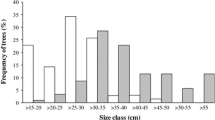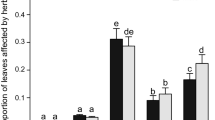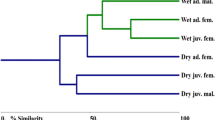Summary
To evaluate the general extent to which sex-related differences in palatability occur in boreal dioecious woody plants, males and females of five dioecious woody plant species were presented to free-ranging mountain hares (Lepus timidus) during winter. Hares strongly preferred branches from male plants when feeding on Populus tremula and Salix caprea and weakly preferred male S. pentandra. However, they did not show any sex-related preference when feeding on the other two species studied (Myrica gale and Juniperus communis). Nitrogen concentration and, to some degree, digestibility showed strong relationships with hare food preferences. By contrast, the concentration of phenolics was only weakly related to feeding preference. Phenolics could, nevertheless, still be important if only one or a few specific compounds deter hare feeding. These results indicate that sex-related differences in plant palatability in the boreal forest might be more widespread than previously believed, particularly for species of the family Salicaceae. Thus, herbivores might be responsible for the female-biased sex ratios found in willow populations in northern Scandinavia (e.g. Elmqvist et al. 1988).
Similar content being viewed by others
References
Ågren J (1987) Intersexual differences in phenology and damage to herbivores and pathogens in dioecious Rubus chamgemorus L. Oecologia 72:161–169
Ågren J (1988) Sexual differences in biomass and nutrient allocation in the dioecious Rubus chamaemorus. Ecology 69:962–963
Alliende MC (1989) Demographic studies of a dioecious tree. II. The distribution of leaf predation within and between trees. J Ecology 77:1048–1058
Boecklen WL, Price PW, Mopper S (1990) Sex and drug and herbivores: Sex biased herbivory in arroyo willow (Salix lasiolepis). Ecology 71:581–588
Bryant JP, Kuropat PJ (1980) Selection of winter forage by subarctic browsing vertebrates: the role of plant chemistry. Annu Rev Ecol Sys 11:261–285
Bryant JP, Wieland GD, Reichardt PB, Lewis WE, McCarthy MC (1983) Pinosylvin methyl ethers deter snowshoe hare feeding on green alder. Science 222:1023–1025
Choo GM, Waterman PG, McKey DB, Gartlan JS (1981) A simple enzyme assay for dry matter digestibility and its value in studying food selection by generalist herbivores. Oecologia 49:170–178
Danell K, Elmqvist T, Ericson L, Salomonson A (1985) Sexuality in willows and preference by bark-eating voles: defence or not? Oikos 44:82–90
Danell K, Elmqvist T, Ericson L, Salomonson A (1985) Are there general patterns in bark-eating by voles on different shoot types of woody plants? Oikos 50:396–402
Danell K, Hjältén J, Ericson L, Elmqvist T (1991) Vole feeding on male and female willow shoots along a gradient of plant productivity. Oikos 62:145–152
Dawson TE, Bliss LC (1989) Pattern of water use and water relations in the dioecious shrub, Salix arctica: the physiological basis for habitat partitioning between the sexes. Oecologia 79:332–343
Elmqvist T, Gardfiell H (1988) Differences in response to defoliation between males and females of Silene dioica. Oecologia 77:225–230
Elmqvist T, Ericson L, Danell K, Salomonson A (1987) Flowering shoot production, and vole bark herbivory in a boreal willow. Ecology 68:1623–1629
Elmqvist T, Ericson L, Danell K, Salomonson A (1988) Latitudinal sex ratio variation in willows, Salix spp., and gradients in vole herbivory. Oikos 51:259–266
Hörnfeldt B (1978) Synchronous population fluctuations in voles, small game, owls and tularemia in northern Sweden. Oecologia 32:141–152
Karlsen S (1983) Winter food preference of mountain hare in Norway. Finn Game Res 41:67–74
Milton K (1979) Factors influencing leaf choice by howler monkeys: a test of some hypotheses of food selection by a generalist herbivore. Am Nat 114:362–378
Price PW, Waring GL, Julkunen-Tiitto R, Tahvanainen J, Mooney HA, Craig TP (1989) Carbon-Nutrient balance hypothesis in within species phytochemical variation of Salix lasiolepis. J Chem Ecol 4:1117–1131
Pulliainen E (1982) Habitat selection and fluctuations in numbers in a population of the arctic hare (Lepus timidus) on a subarctic fell in Finnish forest Lapland. Z Säugetierk 47:168–174
Pulliainen E, Tunkkari PS (1987) Winter diet, habitat selection and fluctuation of a mountain hare Lepus timidus population in Finnish forest Lapland. Holarct Ecol 10:261–267
Singelton VL, Rossi JR (1965) Calometry of total phenolics with phosphotungstic-phosphomolybdic acid reagents. Am J Enol Viticult 16:144–158
Tahvanainen J, Helle E, Julkunen-Tiitto R, Lavola A (1985) Phenolic compounds of willow bark as deterents against feeding by mountain hares. Oecologia 65:319–323
Author information
Authors and Affiliations
Rights and permissions
About this article
Cite this article
Hjältén, J. Plant sex and hare feeding preferences. Oecologia 89, 253–256 (1992). https://doi.org/10.1007/BF00317225
Received:
Accepted:
Issue Date:
DOI: https://doi.org/10.1007/BF00317225




